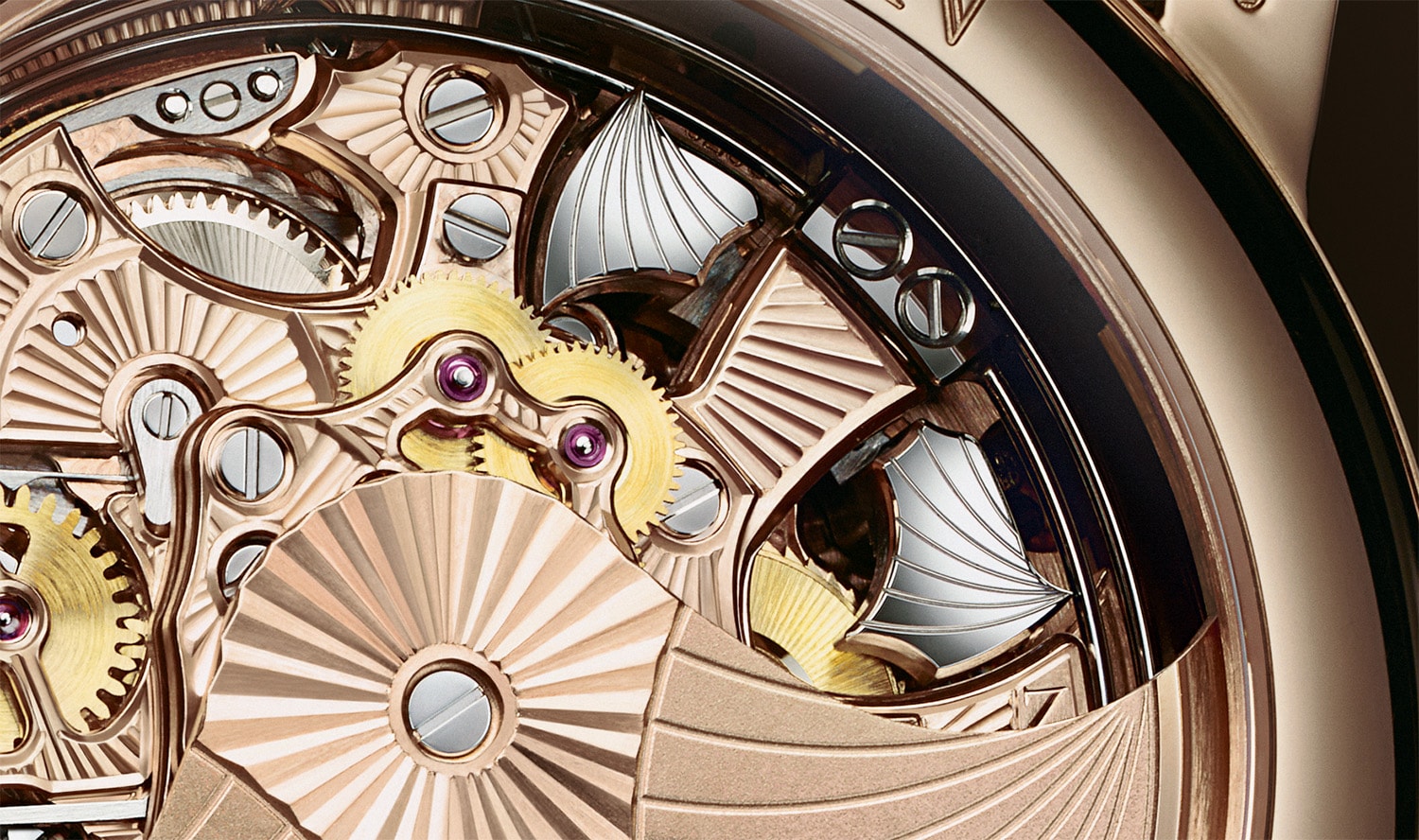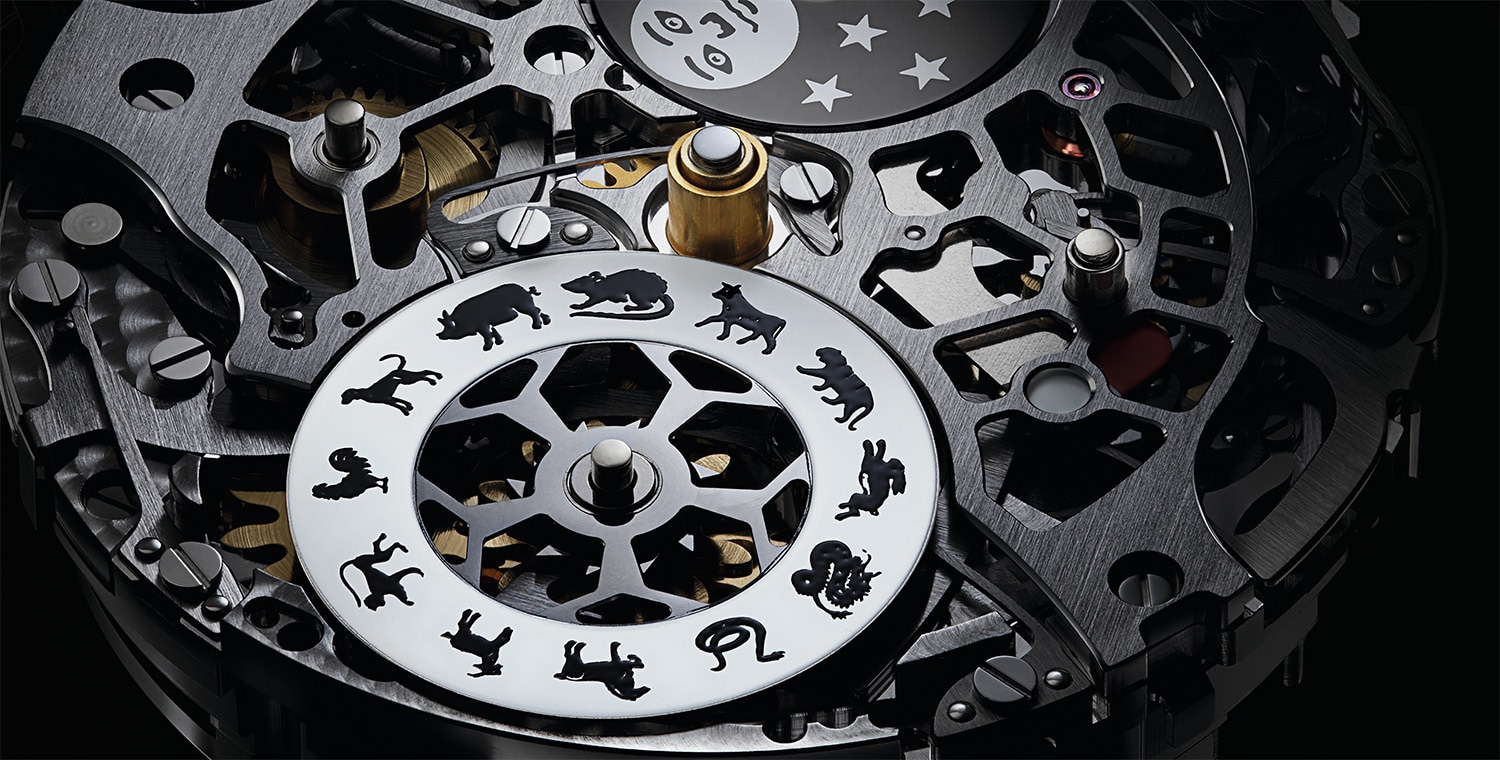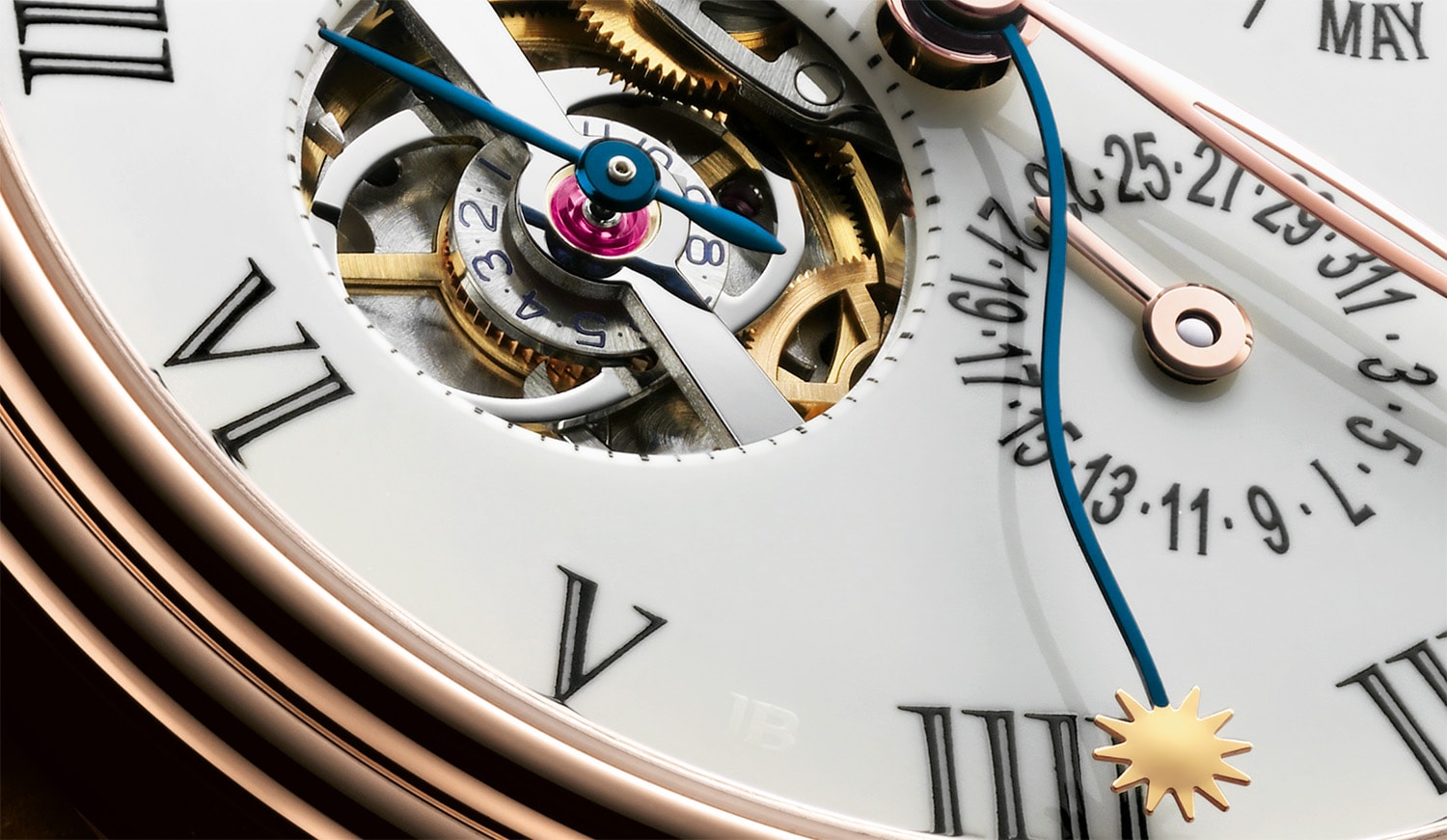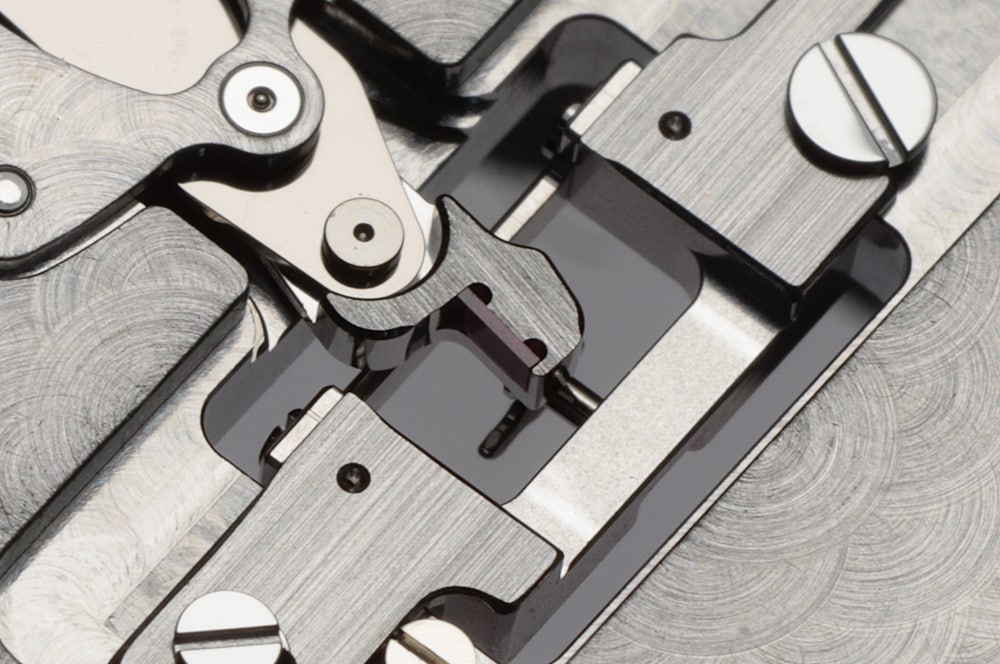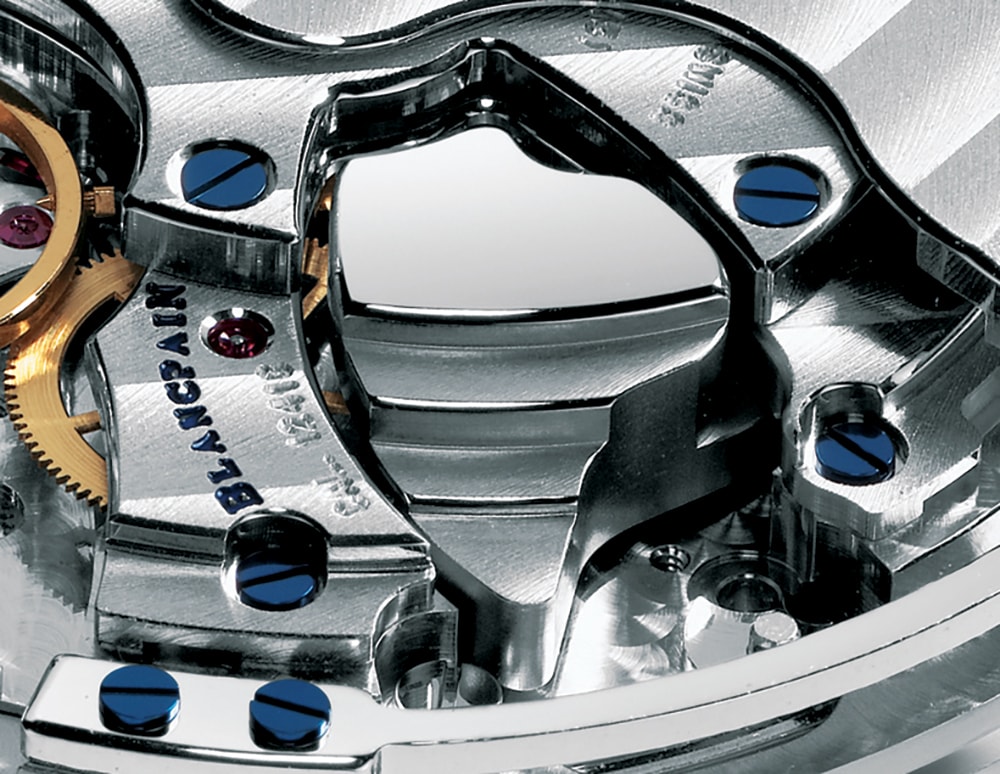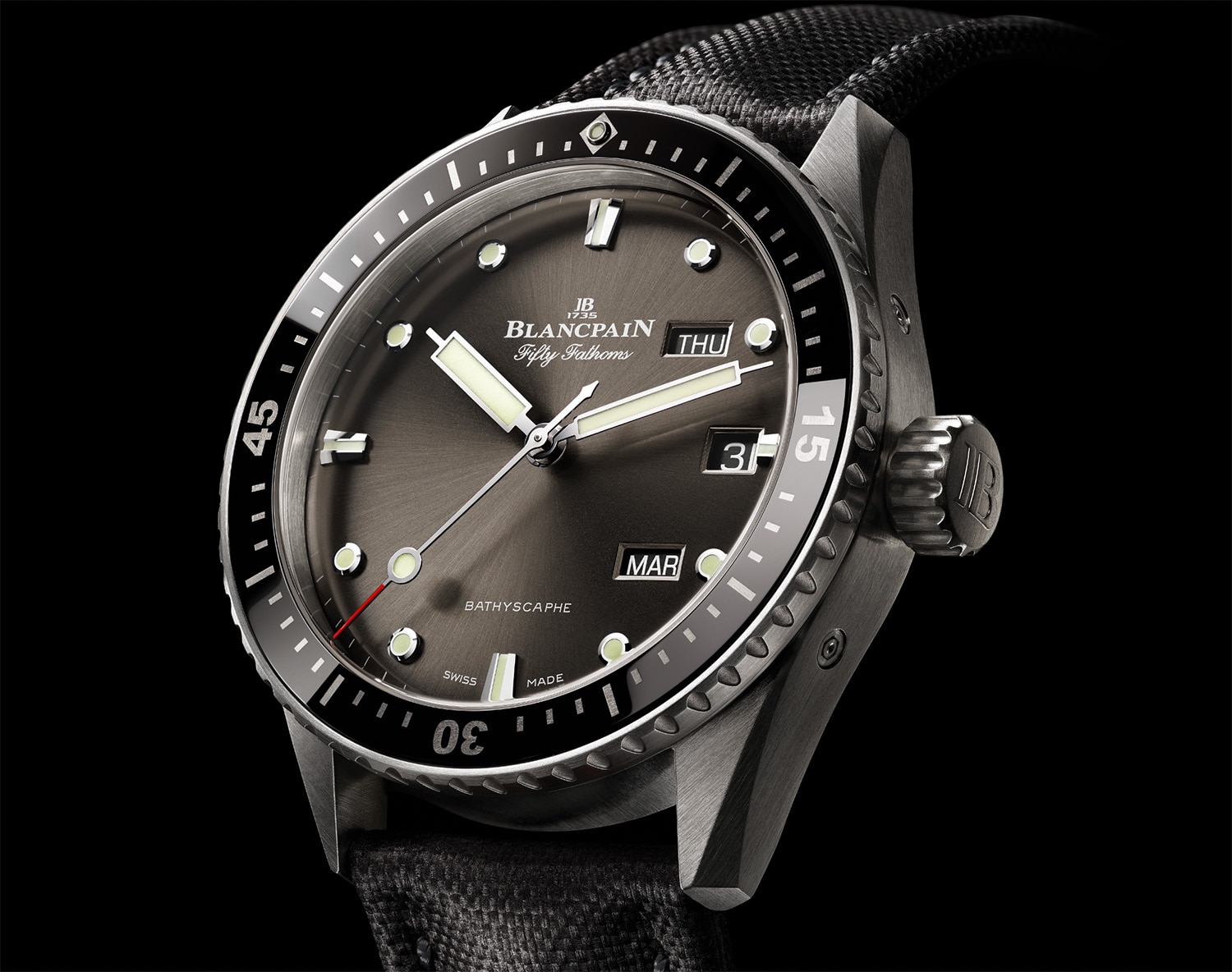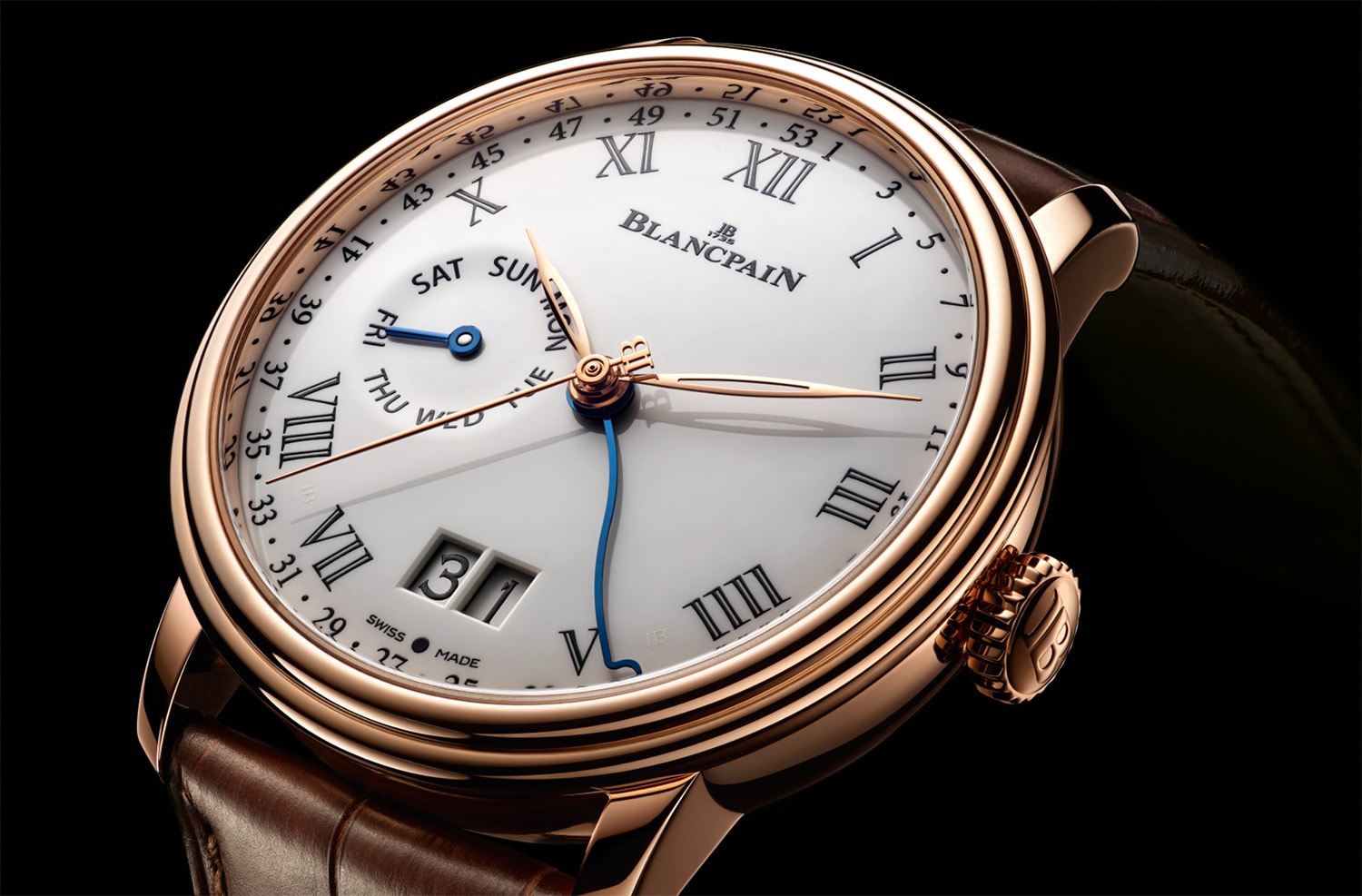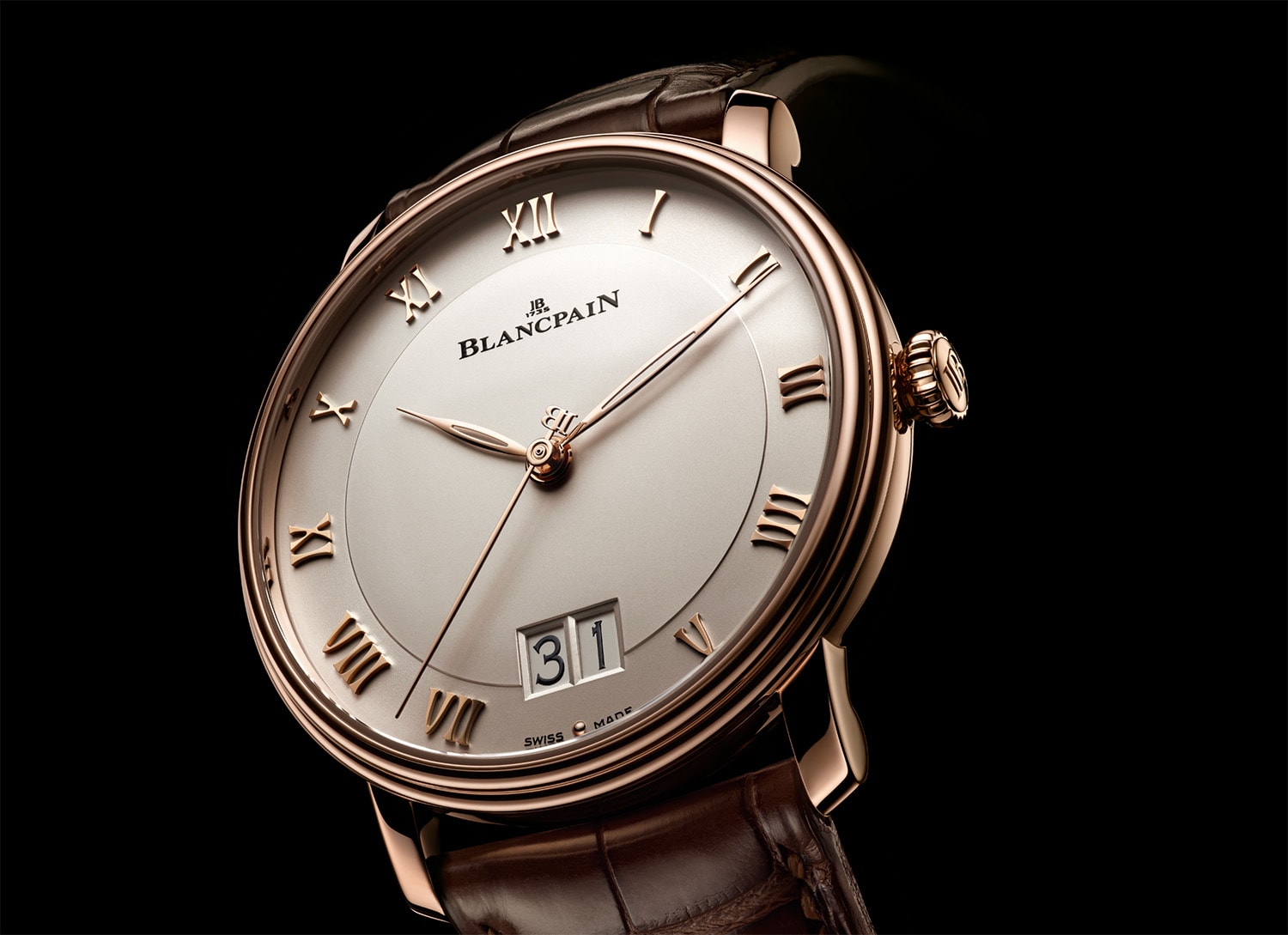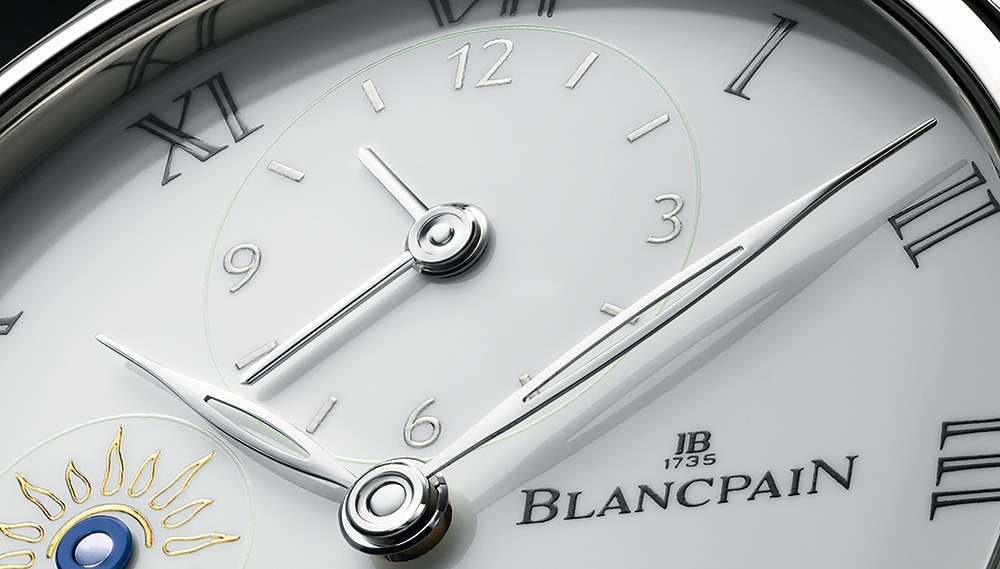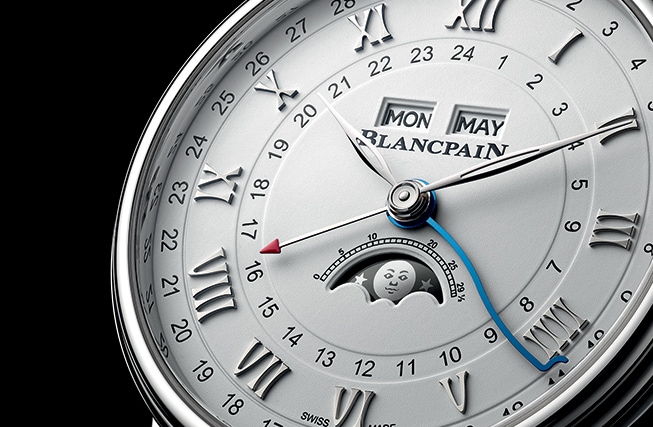复杂功能是对制表艺术的终极诠释。宝珀Blancpain表厂汇集打造复杂功能需要的所有顶级技能。我们的复杂功能囊括日历(全历、年历或万年历)、月相、日历、时间等式、双时区时间、闹铃、陀飞轮、卡罗素、计时码表(双追针、单按钮和飞返)、跳时、逆跳分钟或秒钟、深度计以及三问报时(带有自动人偶或不带自动人偶)。将复杂功能搭配组合也是宝珀Blancpain得心应手的专长。
我们的机芯完全由品牌自主制造,在制表领域无可匹敌,彰显出品牌精湛技艺和超卓工艺。
Minute-repeater
The minute-repeater is a complication that is outstanding in the watchmaker’s art. Initially conceived so that it would be possible to tell the time in the dark, it remains one of the most appreciated complications and one of the most difficult to make. Thanks to a complex mechanism comprising two gongs struck by hammers and a mechanical memory activated by means of a slide, the minute-repeater sounds the hour with two tones. A low-pitched chime sounds to indicate the hours, followed by two rings – the first high, the second low – for the quarter-hours, and lastly a high note for each minute. In order to guarantee the purity and musicality of the striking mechanism, it is essential to make a very careful selection of metals and adjust each movement by hand. The construction of a minute-repeater is so demanding that only a few of these watches, individually numbered, leave our Le Brassus workshops each year.
Blancpain played a pioneering role in the development of minute-repeater watches. We have carried out considerable research into improving the tone of our mechanisms. Our minute-repeaters are equipped with cathedral gongs whose blades extend one and a half times around the movement, so producing a sound of exceptional quality. The acoustic purity of our timepieces is further guaranteed by the use of balance-wheels that help reduce the background noise produced by the mechanism.
Carrousel
A complication that was forgotten by the big names in watchmaking for more than a century, the carrousel seeks to reduce the effects of the earth’s gravity on the functioning of the movement. It is thus an alternative to the tourbillon, distinguished from it by its functioning principal. The carrousel is linked to the barrel by two gear trains. The first provides the energy required for the functioning of the escapement, while the second controls the cage’s speed of rotation. In reviving this mechanism, scaled down in size to wristwatch proportions for the first time, and affording it a new lease of life, Blancpain has made watchmaking history. Blancpain’s Carrousel Volant Une Minute is the first to have a cage that makes a full rotation in one minute. Not only did this model mark up a whole series of world firsts when it was presented in 2008, but it remains unique in the watchmaking world today. In order that the owner can admire this ingenious system, an opening at 12 o’clock on the dial reveals the carrousel. A refined presentation brings out the beauty of this elegant mechanism whose upper bridge takes the form of a hand to indicate the seconds.
Tourbillon
The tourbillon is one of the most striking watchmaking innovations of the 18th century. This complication takes into account the influences of the earth’s pull on watches’ running precision, which vary with a watch’s position, and corrects them through having the regulating organ (sprung balance and escapement) built into a cage that is set in rotation. In its most classical form, the cage accomplishes one rotation per minute. As this assembly turns in all the vertical positions, it is subjected in an identical manner to phases of acceleration and deceleration. In this way, the effects of gravity are compensated for and cancelled out. Over the years, Blancpain has developed a number of models combining the tourbillon with other complications such as the chronograph, the perpetual calendar and the highly exclusive “1735”. We also presented the first flying tourbillon, whose particular feature was its unusual construction, with upper bridge removed to offer an unobstructed view of its principal components. In 2018, Blancpain took this concept even further in the Villeret Tourbillon Volant Heure Sautante Minute Rétrograde model, replacing the lower bridge with a transparent sapphire disc. The tourbillon cage, its balance-wheel and its escapement thus appear to float in the air above the fixed wheel, attached to the sapphire disc.
Traditional Chinese Calendar
With the Traditional Chinese Calendar, Blancpain rose to the challenge of mechanically uniting two different interpretations of time. Five years of research and development were necessary to enable the principal indications of the Chinese calendar and the Gregorian date to appear alongside one another in the heart of a timepiece. Since the base units of these two systems for dividing time are not the same, this was a veritable technical feat. While the Gregorian calendar’s is the solar day, the Chinese calendar – referred to as lunisolar – is centred on the cycle lunar cycle, comprising 29.53059 days. And a year of twelve lunar months is about eleven days shorter than a solar year. In order to preserve alignment with the cycle of the seasons, an intercalary month is added to the Chinese calendar every two or three years. It is this particularity that lies behind the variability in the date of the Chinese New Year. But the calendar’s complexity does not stop there. It involves a system of subdivision of the day into 12 double hours, which replace the Gregorian calendar’s 24 hours of 60 minutes. Each of these double hours is named after one of the twelve earthly branches, in order, and is represented by one of the animals of the Chinese zodiac. Blancpain’s Traditional Chinese Calendar is a watchmaking masterpiece whose creation surpasses the perpetual calendar in complexity. Each watch is fully assembled and painstakingly adjusted by hand by a single master watchmaker in the Grand Complications workshop of our Le Brassus Manufacture.
Perpetual Calendar
The perpetual calendar is a veritable mechanical memory capable of indicating the day of the week, the date, the month and the leap year. This calendar takes account of the variations in length of the months and requires no manual date adjustment until 2100, a special feat that requires highly advanced expertise.
In 2004, keen to take the watchmaker’s art into uncharted territory, the Blancpain Manufacture unveiled the world’s first correctors to be located under the horns, for use with a perpetual calendar. This patented system allows correction of the calendar’s indications with simple pressure of the finger, without need for a correction tool. Placed beneath the horns, the correctors are invisible when the watch is worn. Consequently, Blancpain’s perpetual calendars are characterised by a smooth and sleek middle, unmarred by the small “dimples” that one usually finds on calendar watches.
Running Equation of Time
The equation of time features among the rarest and most fascinating watchmaking mechanisms. It links the watch to the sun’s cycle, so that it can display the difference between true solar time (solar hours and minutes) and mean solar time (civil hours and minutes). The sun has been used as the basis for time since Antiquity. However, the apparent movement of the sun – the true solar time indicated by sundials – is not regular. For convenience, the decision was made to divide the day into 24 hours of equal length. While very useful for the needs of civil life, this standard does not correspond to the actual duration of a solar day, deviating from it by between +16 and -14 minutes. Four days per year, the errors cancel each other out and the true and mean times correspond exactly. The variations between true and mean solar time recurring in an identical manner on the same date each year, it was possible for the watchmakers to reproduce them mechanically and provide an indication for them, generally on an auxiliary sector or dial. It was then up to the user to make a mental addition or subtraction of the deviation displayed to determine the true solar time. Once again, Blancpain has ventured into the upper realms of watchmaking complications in creating the Running Equation of Time, the first wristwatch to feature a “running” equation of time. In this model, the dial is equipped with two coaxial minutes hands, with one indicating mean solar time (that seen on clocks and watches) and the other true solar time (that of the sundials, reflecting the elliptical nature of the earth’s orbit around the sun). This innovative system, particularly functional and easy to read, allows direct reading of true solar time, with no need for the mental calculations required by traditional equation-of-time watches.
Mechanical Depth Gauge
The mechanical depth gauge is a complication built into Blancpain’s X Fathoms model enabling depth measurement to 90 metres and recording of the maximum depth reached. It comes with a separate display for the 0-15 m range, with an exceptional precision of +/- 30 cm, and a retrograde five-minute counter for the decompression stops. Research carried out by Blancpain showed that the elasticity and resistance to permanent deformation of an amorphous metal make such a metal an ideal material for the fabrication of the depth gauge’s central component: the membrane. This choice allowed its thickness to be reduced to half that of a steel membrane, with a consequent gain in precision. To guarantee maximum precision of the depth indications, Blancpain calibrates each of its X Fathoms timepieces individually.
Flyback Chronograph
The flyback chronograph allows the direct measurement of successive time intervals. With an ordinary chronograph, three consecutive presses on the push-pieces are required to measure a succeeding time interval: stopping of the chronograph, resetting to zero and restarting. With the flyback function, a single press on the flyback push-piece stops the measurement of the first interval and resets the hand to zero. The chronograph hand resumes its course immediately when the push-piece is released. Appreciated by pilots for the time-saving it allows, this complication is particularly suited to aviation and navigation, but also to scuba diving. In addition, Blancpain’s flyback chronograph watches are water-resistant and operational to 10 bar, or even 30 bar for the models in the Fifty Fathoms collection.
Annual Calendar
The annual calendar watch indicates the date, that is to say the number of days into the month, automatically taking account of the variations in length between months. Unlike the perpetual calendar, the annual calendar does not take into account either the special case of February, which is treated like a month of 30 days, or leap years. It therefore needs to be manually corrected once a year, at the end of February. At Blancpain, the date is displayed on the main dial by means of an additional hand, or in a specific aperture.
Complete Calendar
This complication indicates the date, the day of the week and the month. The changing face of the moon, reproduced on the dial, gives it a poetic touch.
The Blancpain timepieces fitted with a full calendar display the day of the week and the month in two apertures. The date is indicated by means of a central hand. In the Villeret collection, it takes the form of a serpentine hand in blued steel, in reference to an 18th-century watchmaking tradition, which required a watch to display any secondary information using a hand of characteristic shape. Unlike the annual and perpetual calendars, the full calendar does not take account of the variations in month length and needs to be corrected five times per year, at the end of each month of less than 31 days. The reproduction of the lunar cycles on the dials of Blancpain’s full-calendar watches evokes the ancestral links between watchmaking and astronomy. The moon-phase timepieces indicate whether the moon is new, waxing, full or waning. The face of the moon corresponding to the current lunar phase is visible through an opening in the dial.
Calendar Week
The Calendar week indication is a complication that enables the week number (number of weeks into the year) to be displayed on the watch’s dial. Much appreciated these days, this information is indicated by a central hand that points to one of the numbers displayed around the outer rim of the dial. The change in week number takes place at midnight, on the passage from the Sunday to the Monday, in parallel with the changing of the date. The numbering from 1 to 53 reminds us that certain years are officially allocated 53 weeks: this will be the case in 2020, then in 2026, to cite just instances in the near future. Designed with the idea of being as useful as possible, Blancpain watches displaying the week of the year are also provided with a large date and indications of the day of the week and power reserve. Correction of the week-number indication is independent and is a simple operation, thanks to a corrector located beneath the case that is easy to manipulate with the tip of a finger.
Large Date
This refined and useful complication displays the date within the month in large numerals in two apertures. The date is displayed by a combination of two discs via two large apertures placed side by side. The first disc indicates the tens and bears the figures 0 to 3, while the second indicates the units, from 0 to 9. Perfect synchronisation of the two discs is necessary. The large date mechanism developed by Blancpain stands out for its ingenuity. Going beyond the larger display of the date and its instantaneous changing at midnight, the Blancpain timepieces equipped with this complication distinguish themselves by their optimal energy efficiency, with a consequent saving in power reserve. In addition, they are slimmed down to a minimal depth for accentuated elegance, while still being protected against shocks.
Moon phases
The reproduction of the lunar cycles on the dials of Blancpain watches evokes the ancestral links between watchmaking and astronomy. The moon-phase timepieces indicate whether the moon is new, waxing, full or waning. The face of the moon corresponding to the current lunar phase is visible through an opening in the dial, located at 6 o’clock. The phases of the moon are indicated by means of a wheel of 59 teeth, which covers two full lunar cycles of 29.5 days. This is why the moon is depicted twice on the disc turned by this wheel. The moon-phase mechanism is activated once per day, towards 6 p.m., by means of a gear-train.
On certain women’s models, Blancpain’s cherished attention to detail can be seen on the moon’s charming feminine face, where a fly lingers on the corner of its smile.
Half Time Zone
This complication concerns the double-time-zone watches. It makes it possible to adjust the second zone time by precise jumps of 30 minutes, making for totally relaxed travel in those countries where the time lag between GMT and the local time is an odd number of half-hours. Unlike the usual GMT mechanisms, in which the correction of the hours hand is made in steps of an hour, the half-time-zone watches involve the moving of two hands, that of the hours and that of the minutes. Their production is therefore considerably more complex.
With their half-time-zone timepiece, Blancpain have privileged convenience of use. The Manufacture developed an ingenious system for controlling three functions from the crown, by the use of a selector to choose between correction of the local time and correction of the date. This selector is fitted with a column-wheel that ensures incomparable precision and an action that feels as smooth as velvet on use of the push-piece located on the crown.
三问报时
三问报时是制表领域一项主要的复杂功能。设计初衷是为让人们在黑暗环境中也可以知晓时间,至今仍旧是最难打造,但也最受青睐的一项复杂功能。
三问报时的机械结构极为复杂,包括两枚由音锤敲击的音簧和通过滑块启动的机械记忆装置,能够以两种乐音报时。最初洪亮的低音表示小时,之后一高一低表示刻钟,最后以高音表示刻钟之后经过的分钟。为确保报时声清脆悦耳,必须仔细甄选金属材质,并对每一枚机芯进行手工调整。三问报时制造过程中的要求极为苛刻,因而Le Brassus工坊所打造的此类表款屈指可数,每一枚均带有专属编码。
卡罗素
卡罗素是被制表大师们遗忘了已逾一个世纪的复杂功能,其作用是降低地心引力对机芯运行带来的影响。因而它可作为陀飞轮的替代品,但实现功能的方式有所不同。卡罗素通过双齿轮传动链连接至发条盒。一条用于传输擒纵机构运行所需的能量,另一条则控制框架的旋转速度。宝珀Blancpain率先在腕表中的狭小空间内,以这种精妙的工艺为其赋予全新的面貌,铸就了制表史上的一座里程碑。宝珀Blancpain的Carrousel Volant Une Minute一分钟飞行卡罗素腕表首创性地配备了一分钟恰好完成一周旋转的框架。2008年,该表款问世时开创多项全球首例,时至今日在制表领域中依然独树一帜。12点钟位置的开窗让卡罗素巧妙绝伦的机械结构毫无保留地呈现在欣赏者眼前。呈指针形状的上表桥用于指示秒钟,为优雅的结构锦上添花。
陀飞轮
陀飞轮是18世纪制表领域最杰出的一项创新。这项复杂功能考虑到地心引力对于腕表处于不同位置时的影响,将调校机构(摆轮、游丝和擒纵机构)整合在一个旋转框架中,从而抵消这种影响。在最经典的陀飞轮中,框架每分钟旋转一周。整个框架连续经过所有的垂直位置,以这种方式经历加速与减速的阶段,从而让地心引力的影响得到校正并抵消。
中华年历
凭借中华年历功能,宝珀Blancpain将两种不同的时间诠释方式结合在同一种机械结构中。表厂耗费五年时间研发,最终实现在一款时计中融合中华年历和公历两种显示。两种时间划分系统的基础单位各不相同,这是一项真正的技术壮举。公历的基础为太阳日,中国历法则为阴阳历,对应月球的周期变化,每月包含29.53059天。因此,包含十二个阴历月份的一年比太阳年要短约11天。为保持与季节周期的一致性,中国历法中每隔两到三年需要加入一个闰月。这种独特性导致中国新年的日期变化不一。然而,这种历法的复杂之处远不止于此。它还采用每天12时辰的划分系统,替代公历中每小时60分钟、每天24小时的划分法。十二时辰依据十二地支依次命名,并分别以十二生肖中的动物表示。
不停运转的时间等式功能
时间等式功能是最为珍贵、最为令人惊叹的一项制表机械机制。时间等式是腕表中与太阳运转周期息息相关的一项功能,真太阳时(太阳小时与分钟)与平太阳时(民用小时和分钟)之间的偏差便以时间等式来表示。
自古以来,人们都是以太阳作为衡量时间的基础。然而,太阳的实际运转(日晷所指示的真太阳时)并不规则。出于便捷性考虑,人们将每一天定为等长的24小时。然而,这一规则只是应日常生活所需而采用的实用性方案,而与太阳日的真正长度并不完全相符,太阳时与民用时之间的累计偏差从+16分钟到-14分钟不等,而每年当中有4天这种偏差会消失,即真太阳日与平太阳日的长度完全吻合。由于真太阳时与平太阳时之间的偏差在相同日期重复出现,令钟表师得以通过机械装置再现这一偏差,通常通过表盘上的特定区域或副表盘显示并指示。使用者则需要在心里添加或减去查看到的偏差,自行计算出相应的真太阳时。
机械测深仪
机械测深仪是宝珀Blancpain X Fathoms腕表配备的一项复杂功能,能够测量90米深度,并记忆最大深度。它将精确至极,误差仅为+/- 30厘米的0-15米区域分离显示,与用于潜水时分阶段减压的5分钟回跳计数器相结合。
飞返计时码表
飞返计时码表用于直接进行连续计时。
在普通的计时码表中,为了连续测量多个时间段的长度,佩戴者必须连续按压按钮三次:一次用于停止计时码表,一次用于将其归零,一次用于再次开始计时。配备飞返计时功能的腕表,按压“飞返”按钮一次即可停止记录第一段时间,同时将指针归回零的位置。在松开按钮后,计时指针立即再次开始运转。
GMT两地时间响闹功能
这项复杂功能非常实用,可让闹铃在预定的时间响起。12小时定时器位于3时位置,以两根指针指示闹铃预定响起的时间。按下位于8时位置的按钮可通过导柱轮启动闹铃。“on-off”指示器位于1时位置,清楚显示响闹功能是否处于启动状态。当音锤敲击音簧时发出悦耳的闹铃声。
宝珀Blancpain响闹腕表实用可靠,搭配两项备受旅行家青睐的复杂功能:机械响闹功能与第二时区显示功能,即GMT两地时间复杂功能。腕表亦搭载日期显示功能,当日期往前或往后调校时,第二时区的时间也会随之改变。
全历功能
这项复杂功能可显示日期、星期和月份,表盘上的月相盈亏变化为腕表营造出如诗一般的意境。
宝珀Blancpain的全历腕表通过两个视窗显示星期和月份。日期则由中置指针指示。在Villeret系列中,这是一根蛇形蓝钢指针,根据18世纪的制表传统,这种特别形状的指针,专门用于指示腕表所提供的次要信息。与年历或者万年历不同,全历功能未有顾及各月份的不同长度,因此每年需要校正五次,分别在天数少于31天的月末。
周历功能
周历是在表盘上显示一年中周数的一项复杂功能,在现代生活中,人们非常需要这项信息。在周历功能腕表中,一根中置指针指向印刻于表盘外缘的数字,显示当前所处的周数。在星期日与星期一交接的午夜,周历显示与日期显示同步变更。
其数字设定为1至53,因为根据正式的历制,某些年份包含53个星期:即将来临的这些年份包括2020、2026年。
大日期窗口
这项复杂功能典雅而实用,通过两个视窗以大号数字显示日期。日期读数由两个圆盘组成,它们设于并排的两个宽阔视窗下。第一个圆盘显示十位数,其上印有0到3的数字,而第二个圆盘则显示0至9的个位数字。这项复杂功能要求这两个圆盘精确地同步运作。
半时区功能
这项复杂功能搭载于双时区腕表,可对第二时区时间以30分钟为单位进行调整,使旅行者在时差为半小时的国家时能够应对自如。
传统的GMT双时区装置能够以一小时为单位对时针的位置进行调整,与之不同的是,半时区装置更为复杂,它需要对时针和分针均进行调整。
